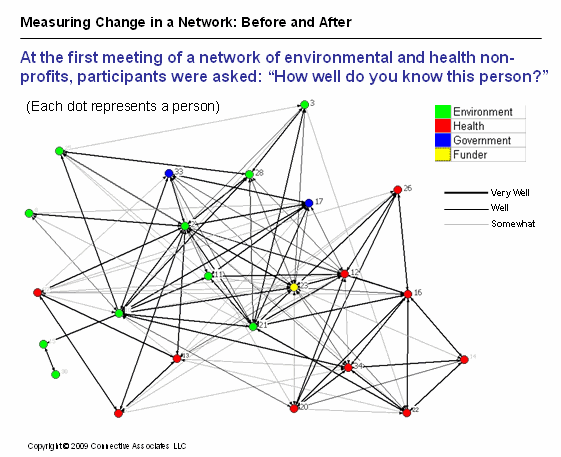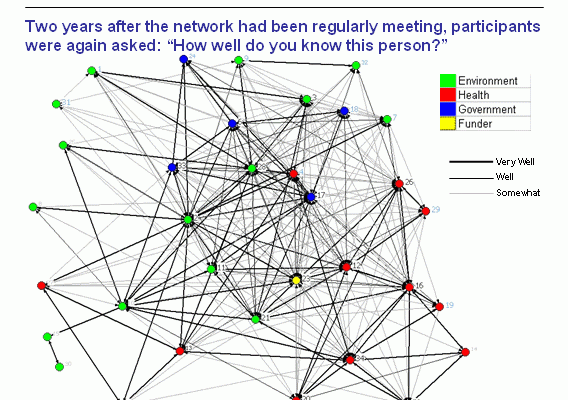New Directions Collaborative helps our clients “map” their networks, using Social Network Analysis (SNA) and other tools, to develop a visual images of relationships and flows of information/communication and other dimensions of interest. Seeing images of a network’s relationships makes what is invisible visible and out of this, new information can emerge, for example, seeing which people are well connected in a network and where parts of a network are not aware of each others’ work. (See example below.) Network maps can be re-done on a periodic basis to measure changes over time, which provides useful data in evaluating network effectiveness and setting strategy.
We help networks determine what maps or inventories will be useful based on their goals and state of network development. Participants in the network compile a brief survey and this data is entered into software that generates various maps and analysis. Using the maps as a starting point, we facilitate dialogue amongst network leaders and members about how the network is currently working and what actions or interventions could be taken to unleash the network’s capacity to advance change.
Examples of a few of the ways to map a network include:
- Assess the strength of relationships within the network, e.g., how well people know other members, how often they communicate, who works with whom. This map is designed in a way that this survey could be repeated in future years to analyze changes over time, as one way to assess the network’s impact.
- Develop a matrix to see where network participants’ strategies and focus overlap or where there are gaps or overlaps. This can be tailored to align with network high-level goals and is useful for the network in planning and for helping members see how they can align and organize their work together more effectively.
- Map the constituencies that network members work with or are connected to, e.g., for a network of organizations focused on energy efficiency this might include residents, businesses, municipalities, etc. This helps the network to plan strategy, coordinate engaging constituencies, and find areas to increase collaboration or coordination.
- Develop an inventory of the needs and offers of network participants. Each network has a lot of resources, skills, experience, and connections among its members that others could use, yet this is often untapped. This inventory helps a network coordinator to connect network participants to others within the network, creating additional benefits for their work through their association with the network.
The following is an example of a “Before and After” network map from the Boston Green and Healthy Building Network. Each dot represents a person and the color shows what type of organization they work with. The lines between the dots represent their relationship, i.e., how well they know each other.

Here is a similar map after two years:

